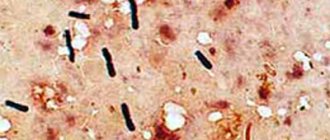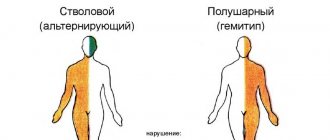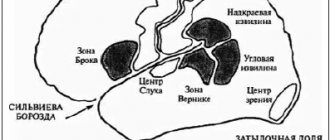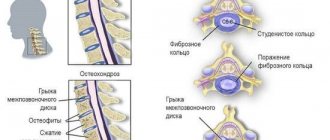Svetlana Shcherbakova
Cardiologist
Higher education:
Cardiologist
Kabardino-Balkarian State University named after. HM. Berbekova, Faculty of Medicine (KBSU) Level of education – Specialist 1994-2000
Additional education:
“Cardiology”
State Educational Institution “Institute for Advanced Training of Physicians” of the Ministry of Health and Social Development of Chuvashia
Contacts
Hypoplasia of cerebral vessels occurs as a result of disturbances in the structure and structure of arteries in humans. This pathology is congenital and is usually found in the left or middle arteries of the brain. Pathology is determined by insufficient vessel mass or changes in size.
Causes
All congenital pathological changes arise due to the influence of many circumstances. As for hypoplasia of the cerebral arteries, the reasons for improper formation of blood vessels are:
- infection of the unborn fetus;
- passion for alcoholic beverages, drugs, smoking;
- taking and inhaling toxic substances, as well as some medications contraindicated during pregnancy;
- genetic predisposition to vascular diseases.
However, there are also situations in which underdevelopment of cerebral vessels is diagnosed in the absence of the above reasons. That is, hypoplasia can also be an independent disease. But this happens quite rarely. It is worth remembering that in the presence of the above reasons, the risk of developing the disease during the formation of the circulatory system of the unborn child increases several times.
Hypoplasia of the A1 segment of the right anterior cerebral artery
The term "hypoplasia" means "underdevelopment". Such defects of intrauterine development are also found in the arteries of the brain. In the arteries of the carotid artery basin, these anomalies exist in approximately 4% of people, and in the arteries of the vertebrobasilar basin - in every tenth person.
Despite the fact that the brain is the most energy-intensive organ and requires massive blood supply, hypoplasia of the arteries that supply it can go unnoticed for a long time. This is due to the characteristics of the cerebral circulatory system.
Most of the hemispheres receive blood from the system of internal carotid arteries, which form the anterior and middle cerebral arteries, as well as the anterior communicating artery. The posterior part of the hemispheres, the brainstem and the cerebellum are fed from the basin of two vertebral arteries, which merge in the cranial cavity into the main artery, from which the posterior cerebral and posterior communicating arteries are formed.
Due to the anterior and posterior communicating arteries, a connection is formed between the arterial basins of the brain, forming a circle.
It is called Willis, and within its limits a compensatory flow of blood into areas with reduced arterial blood flow is possible, including due to hypoplasia of any segment of the artery.
It is this feature of the brain’s blood circulation that ensures the long-term asymptomatic course of most hypoplasias, which often become an accidental discovery.
Clinical manifestations of hypoplasia of the cerebral arteries occur against the background of another pathology that worsens the conditions for compensation of cerebral circulation. Most often this is atherosclerosis of cerebral vessels or diseases of the cervical spine. As a result, transient ischemic attacks and ischemic strokes may occur.
Symptoms
Symptoms of chronic cerebral circulatory disorders depend on the vascular pool in which ischemia of brain tissue develops. All patients may be concerned about:
- headache;
- dizziness;
- noise in the head;
- memory impairment;
- sleep disorders.
Hypoplasia of the carotid arteries is also characterized by weakness and/or numbness in the limbs and speech impairment. For ischemia in the vertebral artery basin - impaired coordination, gait instability.
To diagnose hypoplasia of cerebral arteries and determine treatment tactics, the following are carried out:
- cerebral angiography - X-ray examination of the arteries of the brain with a contrast agent injected into them;
- CT angiography;
- MR angiography;
- ultrasound examination (duplex scanning) of the vessels of the neck and head;
- PAT;
- single photon emission computed tomography.
Conservative therapy with drugs that improve blood supply and metabolism of the brain is carried out if the examination data suggests that it can prevent further worsening of cerebral ischemia and ischemic stroke.
Operations
However, many patients with decompensated blood supply to the brain due to arterial hypoplasia require surgical treatment. The world's leading neurosurgical centers perform complex microsurgical operations for bypassing the arteries of the brain, as well as minimally invasive x-ray surgical intravascular interventions - balloon angioplasty and stenting of arteries.
- Bypass operations on the arteries of the brain provide redirection of blood flow bypassing the area of hypoplasia or narrowing of another origin. Fragments of the patient's arteries and veins are used to form anastomoses. The most common operation of this type is an extracranial microarterial anastomosis between the superficial temporal artery and the middle cerebral artery (it supplies most of the cerebral hemispheres).
The operation takes place under general anesthesia and lasts four to five hours. First, the parietal branch of the superficial temporal artery is isolated (it is located in the integument of the skull). A burr hole is then made in the temporal bone.
And then the operation is carried out using an operating microscope and microsurgical instruments.
The large cortical branch of the middle cerebral artery is isolated and connected to the branch of the temporal artery using a vascular suture made with microfilament.
Subsequently, the patient is first in the intensive care unit and then in the postoperative department for 6-7 days. During this time, control Doppler sonography and MRI of the brain are performed repeatedly.
- Balloon angioplasty is the expansion of the lumen of a vessel using an expanding balloon, which is inserted using a catheter through a puncture of a peripheral artery under the control of X-ray imaging methods. Such operations are often performed on vertebral arteries when they are hypoplastic.
To maintain normal vessel lumen, balloon angioplasty is often combined with vessel stenting with a special intravascular mesh structure.
Today, large multidisciplinary foreign clinics use more than 400 models of stents. These are self-expanding structures made of materials inert for the body. They have shape memory, can be installed in the area of tortuosity and bifurcations (bifurcations) of blood vessels, and do not deform over time.
Many modifications long-term release drugs from their coating that prevent thrombosis and the formation of atherosclerotic plaques in the stent area. Also relatively recently, fourth-generation stents have been introduced into foreign practice.
These are biodegradable structures that dissolve within several years after performing the function.
What are the consequences of cerebral vascular hypoplasia?
In a healthy person, the left and middle arteries of the head supply the largest part of the blood. If the vessels form incorrectly, the brain will lack oxygen supply and all the necessary nutrients. Consequently, there will be a danger of aneurysm formation (protrusion of the vessel wall due to thinning, stretching) or cerebral hemorrhage (stroke). That is why the pathological development of cerebral arteries is given sufficient attention in neurosurgery, as well as in neurology.
Hypoplasia of the vertebral artery, types of disease
The brain is most often affected by vascular pathologies. Hypoplasia is no exception. This term refers to tissue underdevelopment. The disease may be acquired or congenital in origin. Brain hypoplasia most often has a congenital origin.
Normal blood supply to all organs is formed through the circle of Willis. It consists of large vertebral arteries with left and right branches.
Under normal conditions, these arteries develop evenly. The subclavian artery, which has branches, supplies blood to the skull.
Therefore, cerebral hypoplasia is divided into left-sided, right-sided and bilateral. The pathology gradually causes depletion and dysfunction of the organ.
To eliminate the problem, it is often necessary to undergo urgent surgical treatment, during which blood flow is restored.
Doctors have recorded isolated cases of hypoplasia of the left vertebral artery. Typically, pathological abnormalities occur in the right-sided artery, but in both cases the disease develops slowly. Usually appears in adulthood.
Most specialists do not divide Hypoplasia into left and right. True, there are some specific features that are worth paying attention to when examining a patient.
Symptoms of the anomaly
Signs of hypoplasia of the cerebral arteries depend on the degree of abnormal formation of blood vessels and manifest themselves differently in each person. That is, in some the symptoms are more pronounced, in others their manifestation is not so strong. Often, due to similar symptoms with other diseases, cerebral vascular hypoplasia is not diagnosed for a long time and erroneous neurological diagnoses are made. There are situations when a person learns about the presence of a serious pathology only during the next medical examination. Let us note the main signs of manifestation of pathological development of cerebral arteries:
- often feel dizzy, fainting is possible;
- prolonged headaches and migraines;
- skin sensitivity completely or partially disappears;
- regular increase in blood pressure;
- noticeable decrease in visual acuity and memory;
- lethargic and drowsy state;
- emotional experiences;
- violation of fine motor skills.
If these symptoms are present, we can talk about poor blood circulation in the brain. But in order to refute/confirm the presence of cerebral vascular hypoplasia, you should rush to consult a specialist.
Treatment
No matter how paradoxical it may sound, many patients with moderate hypoplasia of the vertebral artery do not need specific therapy, but only constant monitoring by the attending physician.
As long as the body's adaptive abilities cope with hemodynamic disturbances, and the blood supply to the brain is maintained in full, the disease does not pose a serious threat to health. It is enough to follow the principles of a healthy lifestyle and undergo a preventive examination 1-2 times a year.
But if pathological symptoms increase and hemodynamic changes intensify, then hypoplasia must be treated. In this case, the doctor chooses one of two tactics for managing the patient.
Conservative
Conservative therapy, unfortunately, does not completely cure this congenital anomaly. It is aimed at improving nutrition and blood supply to brain tissue and reducing unpleasant symptoms.
When regularly taking medications prescribed by a doctor, patients note an improvement in their well-being: headaches and dizziness disappear, and the intensity of local symptoms noticeably decreases.
The standard treatment plan includes the following:
- vasodilators (Actovegin, Cavinton);
- neuroprotectors and nootropics (Mexidol, Nootropil, Piracetam, Cortexin);
- for severe dizziness - microcirculation correctors (Betagistin);
- in case of instability of blood pressure - antihypertensive drugs (Amlodipine, Lisinopril);
- if there is a threat of thrombosis, use antiplatelet agents (Trombo-Ass, Pentoxifylline);
- multivitamin complexes (Vitrum Cardio, Centrum Cardio).
Additionally, gymnastics, exercise therapy and physiotherapeutic methods are used:
- electrophoresis;
- DDT - diadynamic currents;
- magnetic therapy;
- mud therapy;
- manual therapy;
- balneotherapy.
Moderate physical activity has a beneficial effect on blood vessels. It will be beneficial to engage in any sport except the most difficult ones.
If a patient decides to use folk remedies for treatment, then this should be done only after consultation with a therapist, because in each case everything is individual.
Surgical
If the vertebral artery is severely narrowed, and medications do not allow blood flow to normalize, then the issue of surgery is decided.
Today, endovascular interventions are very popular in neurovascular surgery, characterized by low invasiveness, lower cost and a small number of side effects:
- Angioplasty is a balloon dilation of a vessel, in which its diameter is restored to normal values. Since the effect of this operation is short-lived, it is usually performed in conjunction with stenting.
- Stenting is a small but effective operation. It consists of introducing and installing a mesh metal tube of anatomically required diameter (stent) in the lumen of a hypoplastic vessel. Thanks to this, the artery takes on a normal shape.
- Reconstructive interventions – removal of the damaged section of the artery with its further replacement with the patient’s own vein.
Diagnostic tests
In the early stages, it is quite difficult to diagnose hypoplasia of the blood vessels of the head. For some people, symptoms of the disease may be mild. But if you contact a neurologist with suspicion of such an anomaly, he will first of all refer you to an ultrasound examination of the vessels of the head and neck. Additionally, the doctor may recommend undergoing a magnetic resonance imaging (MRI) examination with the introduction of a contrast agent. Such research methods help determine the intensity of blood flow through the vessels and the enlargement of arterial walls.
Methods for diagnosing cervical hypoplasia
Due to the fact that hypoplasia of the V4 segment of the right vertebral artery has similar manifestations to other pathologies, it is necessary to carry out diagnostic procedures and instrumental studies necessary for an accurate diagnosis of the patient. Specialists prescribe and carry out:
- tomographic examination of the neck and head area - a method is used with contrast enhancement or the introduction of substances that color the vertebral vessel, filling it,
- the intensity, characteristics of blood flow, internal diameter of the artery can be checked using ultrasound examination of the head and cervical region using duplex angioscanning of the artery located in the spinal canal (cervical region),
- X-ray examination - angiography, allows you to see and evaluate the condition of the vessels: the brain and vertebral left- and right-sided arteries are examined, a special conductor with contrast is inserted through the vessels of the extremities, it is delivered to the vertebral region, the contrast stains it, which makes it possible to study the structural features of the artery,
- clinical blood tests that allow you to determine the level of hemoglobin, the presence of inflammatory processes in blood vessels, and the level of biological substances.
Based on the diagnostic results obtained, the doctor makes a conclusion. If the diameter of the spinal artery on the right is less than normal (3 mm) and less than 2 mm, the diagnosis is confirmed. If the changes affected the left vessel, left-sided hypoplasia is diagnosed. During research, other problems associated with vascular pathologies may be identified, for example: aplasia of the posterior communicating arteries.
Confirmation of vascular disease for many patients can imply important consequences - the establishment of disability or exemption from military service for young men. In each case, the fate of a person with hypoplasia is decided by authorized services.
Drug therapy
Conservative treatment involves the patient taking medications that have a positive effect on brain function: dilate the left/middle arteries, improve blood circulation. Thanks to the use of appropriate medications, the patient’s headaches noticeably decrease, vision and memory are restored, and fainting stops. If a diagnostic examination of the patient reveals thrombus formation in one of the brain vessels, then the doctor prescribes antithrombotic medications to thin the blood.
Surgery
Surgical correction of pathology is prescribed in situations where drug therapy does not produce any results. Modern neurosurgeons prefer to perform endovascular operations. This technique involves introducing a special expander (stent) into the lumen of a narrowed blood vessel. Consequently, the size of the artery increases and blood flow in it normalizes. The result of such an operation depends on the length of the abnormal arteries and the existing connections between them. If a person has a well-developed arterial circle of Willis, located at the base of the brain, then any hematopoietic disorders are compensated independently.
Diagnostics
It is carried out under the supervision of a neurologist; if necessary, a specialized surgeon is involved.
The examination is quite simple, gives high-quality results immediately, not counting difficult situations.
Among the events:
- Oral interview with the patient. To record complaints, make a list of symptoms and put forward hypotheses.
- Anamnesis collection. Doctors are especially interested in the course of pregnancy in the mother, if such data is available. To a lesser extent, lifestyle, habits, hereditary factor.
- Dopplerography of the vessels of the neck and brain. Also duplex scanning. Studies aimed at visualizing tissues, assessing the speed of blood flow and its quality. Determination of violations, their severity, localization. Can be carried out with functional tests. Turning the head, etc. This gives a more complete picture.
- Angiography. Of necessity. For visualization of blood vessels.
- The same effect is achieved through MRI, only the level of detail is many times higher. Appointed in controversial cases.
- General blood test and biochemistry with an expanded picture of the lipid spectrum. As part of the diagnosis of atherosclerosis. Allows you to detect excess cholesterol and other fatty compounds. Which can become the culprit of the disease.
It's enough. If necessary, consultations with other specialists are indicated, but these are speculative individual cases. Other scenarios are unlikely.
ethnoscience
There are no special traditional medicine remedies that can cure hypoplasia of the cerebral arteries. But there are quite good recipes, they eliminate some symptoms of the disease and affect the movement of blood through the vessels:
- It is advisable to drink 1 tsp of olive oil. daily on an empty stomach. Oil increases the body's defenses;
- Every morning, eat 1 tsp before breakfast. honey;
- brew dill seeds if you suffer from headaches (1 tsp per 0.5 liter of hot water);
- lemon balm tea can cope with tinnitus;
- green and herbal teas with ginger root and lemon can improve blood flow in blood vessels and increase the protective functions of the human body.
Preventive actions
In addition to the regular use of medications prescribed by the doctor, the patient can independently restore his health if he adheres to certain rules:
- sleep 8-9 hours a day;
- use special orthopedic pillows while sleeping;
- try to limit work near computer equipment;
- attend any sports sections, lead an active lifestyle, but always know when to stop (for example, work out in the gym without fanaticism, swim in the pool, but no longer than an hour);
- If possible, do not overload yourself emotionally: do not get nervous or angry;
- eat rationally, monitor the amount of vitamins and nutrients consumed;
- carry out preventive examination and treatment during exacerbation of diseases (autumn, spring), increase immunity.
Do not despair if you hear the diagnosis: hypoplasia of the cerebral artery. With such a conclusion, people can live fully until old age. However, in order to avoid unpleasant consequences in 10, 20, 30 years, you need to maintain your condition with medications prescribed by your doctor. Do not forget about preventive measures, and then the diagnosed pathology of cerebral vessels will not be an obstacle to a normal and fulfilling life.










